How we built our Natural Swimming Pond
We are often asked how we created the swimming pond at CHB and love to help others thinking of doing something similar. Whilst we are no experts, we have learnt many lessons the hard way and accumulated quite a wealth of knowledge in the 5 years since we began work. If you’re considering giving it a go, do book in for a stay to try out a swim and we’ll happily talk through the process in as much detail as you like!
There had always been a pond here at CHB. Farmer Searle dug horse ponds to store water for livestock. With Cambridgeshire getting so little rainfall it would dry up each summer and in winter was a stagnant swamp! After eyewatering quotes from swimming pond installers, we did a great deal of research and we came up with a plan to do it ourselves. We needed 5 things:
Water
The old pond had become devoid of life as it dried up every summer so the plants died. When it did rain, the run off from surrounding land was full of nutrients so created algal bloom. The first thing we needed was a good source of water and so a bore hole was installed which pumps water up from 18m below our land.
If this isn’t an option, it is possible to collect all rainwater and divert it into your pond.
Lining
Most information on natural swimming ponds assumes you will install an expensive pond liner (essentially a huge piece of plastic) and while this would have made our life easier at the construction stage, we were keen to try and use the fact that we are on blue clay to our advantage and reduce the expense and environmental impact. A huge digger and dumper were used to sculpt the pure clay into a deep swim zone and a shallower regeneration zone to plant into. Once ‘puddled’ this became a watertight natural lining to our pond into which we could plant.
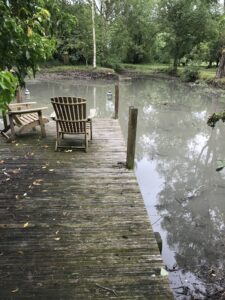
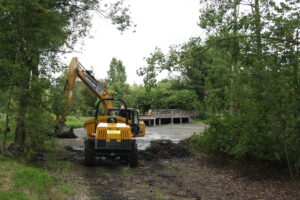
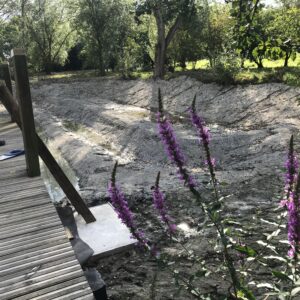
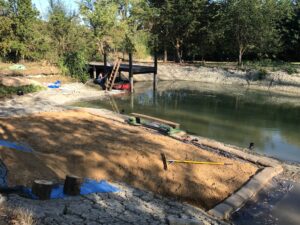
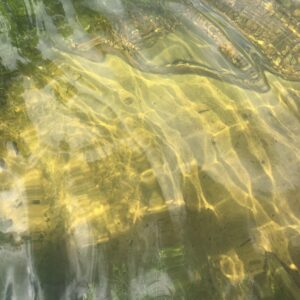
Circulation
It is important to keep the water moving and for the beneficial plants and bacteria on their roots to be able to access the nutrients in the water. Not wanting to use expensive and energy hungry pumps we looked for an alternative solution. Following advice from David Pagan Butler we built some of his amazingly simple ‘bubble pumps’. With an air compressor you create columns of bubbles from aquarium air bricks which gently bring the water with them.
Plants
These do all the hard work for you! Native water plants in shallower area of shingle, under which are perforated pipes leading to the bubble pumps. The water is drawn through their roots and the beneficial bacteria that live in the gravel. They keep the nutrient level of the water to a minimum and provide a safe habitat for all the incredible wildlife that find the pond within hours of filling it!
With those 5 elements in place it should now be a question of simple maintenance. At the end of the summer the vegetation is cut back and removed (it’s great for the compost heap). In the autumn all leaves need skimming off and in spring it’s the blossom petals!
That said, we are still learning and there are plenty of things we wish we’d done differently. Once the pond is full it is quite difficult to make changes and we are often donning a snorkel to carry out work under water! Each year is also so different, the huge amount of rain we had this April caused problems so we are still working to reduce the nutrients and scooping out algae and weeds. I’m going to try adding some (perfectly safe) dye to the water this week as it will prevent the light getting to the weeds and plants under the water (but not impact the marginal plants). We will see if that might help!
Every time we think we’ve got it sussed something else crops up, but working with nature is always going to be unpredictable but incredibly rewarding!